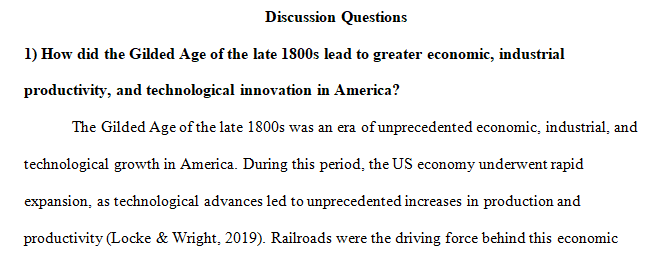How did the Gilded Age of the late 1800s led to greater economic, industrial productivity and technological innovation in America?
How did the Gilded Age of the late 1800s led to greater economic, industrial productivity and technological innovation in America?
Questions assigned Chapter 16 & 18 from The American Yawp
1)How did the Gilded Age of the late 1800s led to greater economic, industrial productivity and technological innovation in America?
Questions assigned
2) What were the common struggles and hardships of industrial workers, populists, African Americans, and women during the Gilded Age?
Questions assigned
3)How did the growth of industry, rise of immigration, and political corruption impact the development of cities during the Gilded Age?
CHAPTER 16: CAPITAL AND LABOR
The Great Railroad Strike of 1877 heralded a new era of labor conflict in the United States. That year, mired in the stagnant economy that followed the bursting of the railroads’ financial bubble in 1873, rail lines slashed workers’ wages (even, workers complained, as they reaped enormous government subsidies and paid shareholders lucrative stock dividends). Workers struck from Baltimore to St. Louis, shutting down railroad traffic—the nation’s economic lifeblood—across the country.
Read more from Chapter 16 of the American Yawp http://www.americanyawp.com/text/16-capital-and-labor/
CHAPTER 18: LIFE IN INDUSTRIAL AMERICA
When British author Rudyard Kipling visited Chicago in 1889, he described a city captivated by technology and blinded by greed. He described a rushed and crowded city, a “huge wilderness” with “scores of miles of these terrible streets” and their “hundred thousand of these terrible people.” “The show impressed me with a great horror,” he wrote. “There was no color in the street and no beauty—only a maze of wire ropes overhead and dirty stone flagging under foot.” He took a cab “and the cabman said that these things were the proof of progress.” Kipling visited a “gilded and mirrored” hotel “crammed with people talking about money, and spitting about everywhere.” He visited extravagant churches and spoke with their congregants. “I listened to people who said that the mere fact of spiking down strips of iron to wood, and getting a steam and iron thing to run along them was progress, that the telephone was progress, and the network of wires overhead was progress. They repeated their statements again and again.” Kipling said American newspapers report “that the snarling together of telegraph-wires, the heaving up of houses, and the making of money is progress.”1
Read the rest of Chapter 18 from the American Yawp http://www.americanyawp.com/text/18-industrial-america/
Requirements: | .doc file
Subject: History
I will be submitting every week on American Yawp.. I know you have worked on these last semester for me. Unless my instructor request anything different i’ll keep you posted thank you. These questions are based off our discussions, which will be used on our chapter exams, the more details (information) the better.
Answer preview for the paper on ‘How did the Gilded Age of the late 1800s led to greater economic, industrial productivity and technological innovation in America?’

APA 929 words
Click the purchase button below to download full answer…….
